Are you curious about what ceiling joists are and why they’re used? If so, then you’ve come to the right place! Ceiling joists play an important role in a building’s construction, as they provide structural support for those areas above us.
In this article, we will explain how ceiling joists work, their purpose in building design and construction, and things to consider when it comes to installing them.
With all of this knowledge under your belt, you can guarantee that any project involving ceiling joists is well taken care of!
What is a Ceiling Joist?
Ceiling joists can also make an insulated space between the attic and living space, which can make the house use less energy.
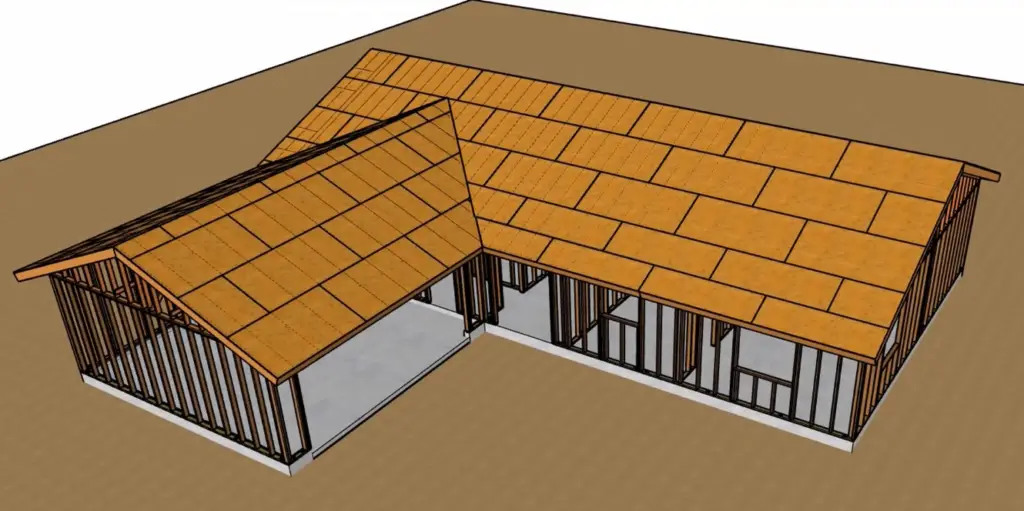
The size of the ceiling joist will depend on the span of the floor system, with wider spans requiring larger, more robust joists.
The type of material used for a ceiling joist is also important to consider; typically, they are made from either wood or steel.
How Far Apart Should Ceiling Joists Be Spaced?
The spacing of ceiling joists depends on the span of the floor system and the weight capacity needed.
Generally, joists should be spaced no more than 16 inches apart for a residential structure but can range from 12-24 inches depending on the specific application. For heavier loads, like concrete slabs or balconies, they may need to be closer together.
You need to think about the space between ceiling joists when you install insulation. The insulation should fit snugly, or tightly, between the joists. This is important because if the insulation is too thick or too thin, it will not work as well. [1]
How is a Ceiling Joist Different From a Floor Joist?
Ceiling joists and floor joists are both used to support the weight of a structure. However, there are some key differences between these two types of joists.
Floor joists are usually bigger than ceiling joists because they need to hold more weight. Also, floor joists are often spaced closer together and have beams to help hold them up, while ceiling joists do not have beams.
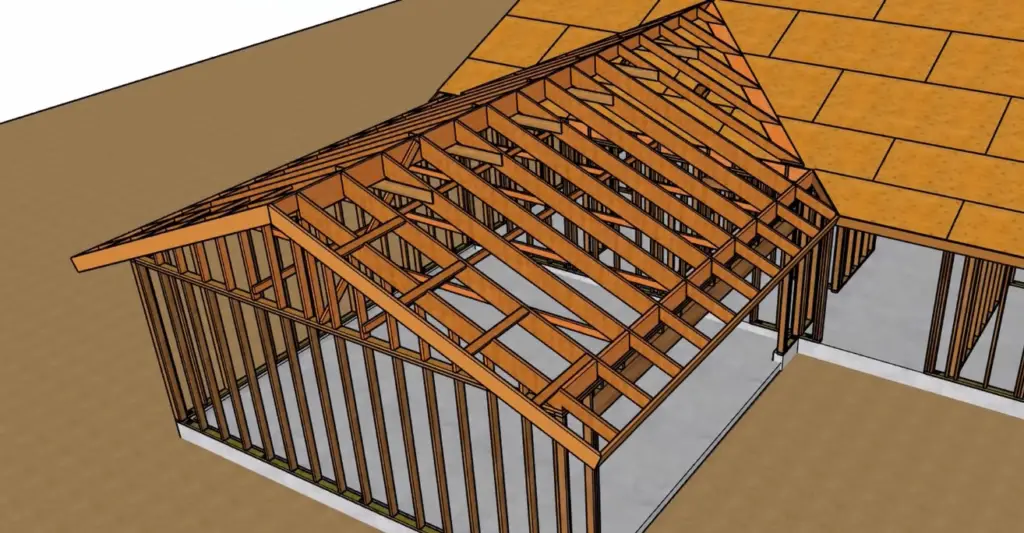
In addition, floor joists are usually made of a more robust material such as steel or concrete, while ceiling joists can be made from lighter materials like wood. Finally, floor joists do not need to be insulated because any heat lost will be transferred to other areas of the house.
What Do Ceiling Joists Look Like?
Ceiling joists usually look like two-by-sixes or two-by-eights. They are often made of wood, and come in different lengths depending on the size of the room they need to cover.
When it comes to installation, the joists should be laid flat and evenly spaced along the walls of the room.
This will make sure that they can hold the weight of whatever is placed on them. You may also see metal or plastic clips used to attach them to one another for added stability.
Ceiling Joist Material
The type of material used for ceiling joists is important to consider when it comes to strength and durability. The most common materials are wood, steel, and concrete.
Wood is a popular choice because it is inexpensive, lightweight, and easy to work with. Steel provides more strength and stability but can be difficult to install. Concrete joists are the strongest and most stable but also the heaviest, making them difficult to install in some spaces.
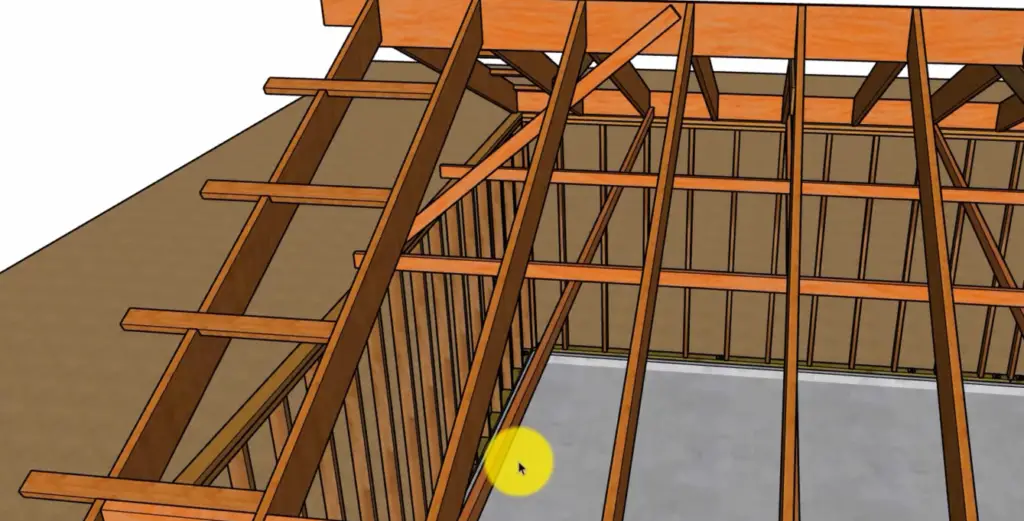
Which Way Do Ceiling Joists Run?
Ceiling joists typically run perpendicular to the walls, from one wall to another. This orientation helps to evenly distribute the weight of the ceiling across each joist and makes them easier to install.
The direction of a ceiling joist also depends on what it is supporting and if there are any load-bearing requirements. For example, in a concrete slab, the joists should run parallel to the walls so the weight is evenly distributed. [2]
Are Ceiling Joists Load-bearing?
Ceiling joists are usually not load bearing, which means they don’t have to hold up a lot of weight. But sometimes they do need to hold up heavy things. If this is the case, the joists need extra support so they don’t break. Always have a professional check the joists to make sure they are safe.
Overall, ceiling joists are an important part of any building’s construction. They help to evenly distribute the weight of a structure and can be made from different materials depending on the application. It is important to understand how they work and what their purpose is before installing them.
Types Of Ceiling Joists
Exposed Ceiling Joists
Exposed ceiling joists are also called “exposed wood framing”. Homes with unfinished ceilings have these joists so people can see them from below. They are usually made of wood and are connected to the walls and roof trusses for support.

Hidden
Hidden ceiling joists are also called “concealed framing”. You usually can’t see these joists because they are hidden. They are often made of steel or concrete. They help support the ceilings, but don’t need to be as strong as exposed joists because you can’t see them.
Ceiling Joist Layout
The layout of the ceiling joists is important because it helps evenly distribute the weight across them. The joists should be laid out in an orderly manner along the walls so that they can support whatever will be placed on them.
When installing ceiling joists, it is also important to make sure that they are level and secure. This will ensure that the ceiling is stable and won’t collapse due to an uneven distribution of weight.
Ceiling Joist Span
The span of the ceiling joist is another important factor to consider when installing them. The span should be determined based on the weight that needs to be supported, as well as the material used for the joists.
Wood joists usually don’t span as far as steel or concrete joists. This means they can’t hold as much weight. Check with a professional before using wood ceiling joists to make sure they will work for your project.
Ceiling joists are a great addition to any building. They help to evenly distribute the weight across the ceiling, provide stability and strength, and can be made from different materials.
When installing them, it is important to consider their orientation, load-bearing requirements, layout, and span. With the right materials and knowledge, ceiling joists can be a great addition to any home or structure. [2]
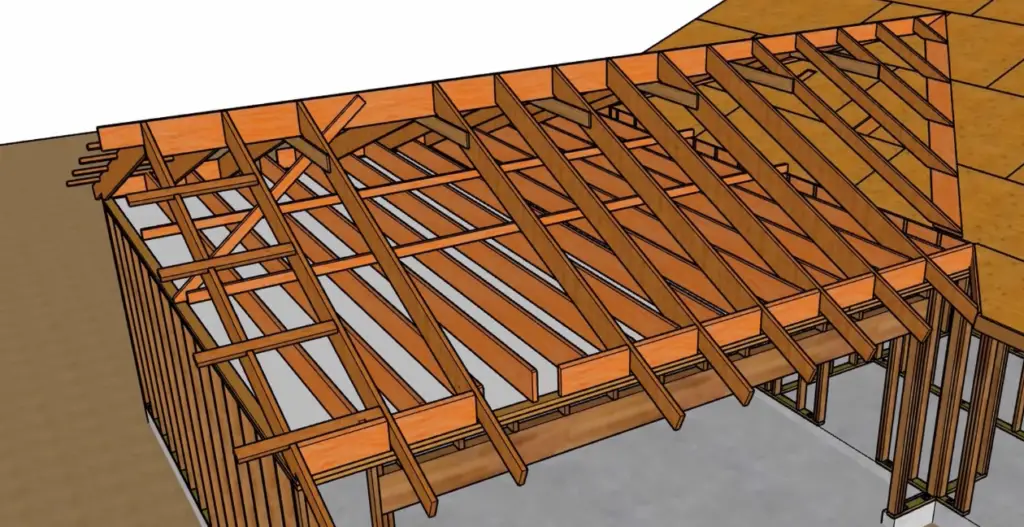
What Is The Standard Ceiling Joist Spacing?
The standard ceiling joist spacing is usually 16 or 24 inches apart, depending on the type of material used. Steel and concrete joists are usually spaced farther apart than wood joists. This helps to evenly distribute the weight across them and makes them stronger.
It is important to follow the manufacturer’s instructions when installing ceiling joists. If the ceiling joists are too close together, they won’t be able to support the weight properly and could collapse.
Ceiling Joists Size
The size of the ceiling joists is also important. The width should be determined based on the weight to be supported and the span of the joists. Generally, wider joists can hold more weight than narrower joists.
The thickness of the joist should be considered because thicker joists are stronger than thinner ones. The thickness should be determined by how much weight needs to be supported by the joist and how long the span is.
Ceiling Joist vs Floor Joist
Ceiling joists and floor joists are both used to support the structure above them. However, there are some key differences between the two types of joists.
Floor joists, on the other hand, have to support more weight and span farther, so they must be thicker and stronger than ceiling joists.
Ceiling joists are also usually made of lighter materials than floor joists, such as steel or concrete. Floor joists are usually made of wood, which is stronger and more durable. [2]
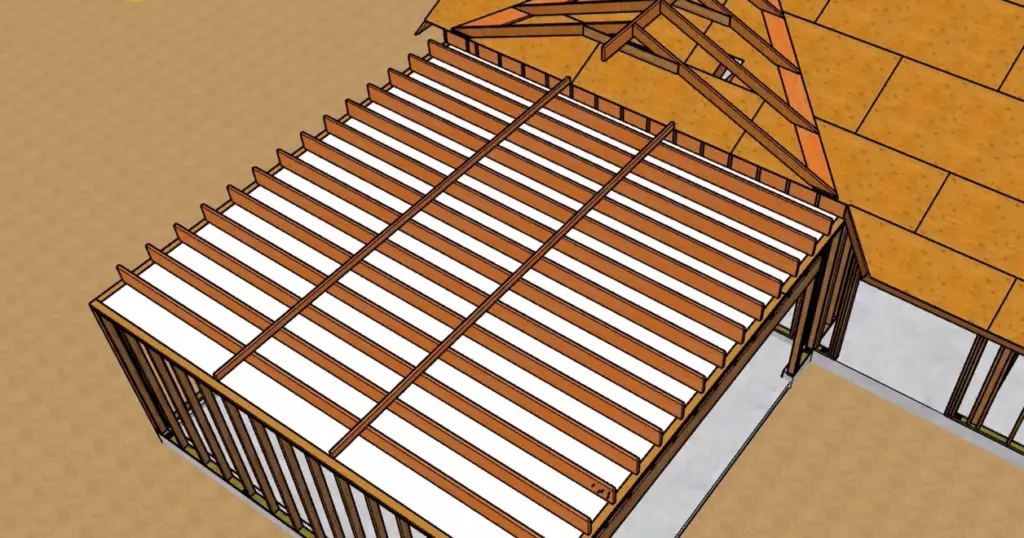
How To Find a Ceiling Joist?
It can be tricky to find an existing ceiling joist, but it is important to look for signs such as cracks in the walls or ceilings, bulges in the floor, or a beam that runs across the room. If you find any of these signs, it may mean that there is a ceiling joist running through them.
If you are unsure, then it is best to consult a professional. They can examine the area and determine if there is a ceiling joist present, as well as how strong and wide they are.
With Stud Finder
You can also use a stud finder to locate existing ceiling joists. Most stud finders will detect the presence of metal and wood, so they should be able to identify the ceiling joist. However, it is important to check that the detector is calibrated correctly before using it.
With Magnets
Magnets can help you find ceiling joists. Place a magnet on the wall and see if it sticks. If it does, there is probably a steel or concrete joist running through that area. This method may not be as accurate as using a stud finder, so use both methods together for more precise results.
What Are the Primary Functions of a Ceiling Joist?
Ceiling joists are used for different things. They help support the weight of the ceiling. They also provide stability and strength. Joists can help to reduce sound transmission between floors, and they can be used to create an airtight seal around ducts and pipes that run through them.
Ceiling joists are an important part of any home or structure, and they help to hold the ceiling up. They need to be installed correctly so that the ceiling is safe and strong. Make sure that your ceiling joists are spaced correctly, that they are the right size for the weight they need to support, and that they are made of the right material.
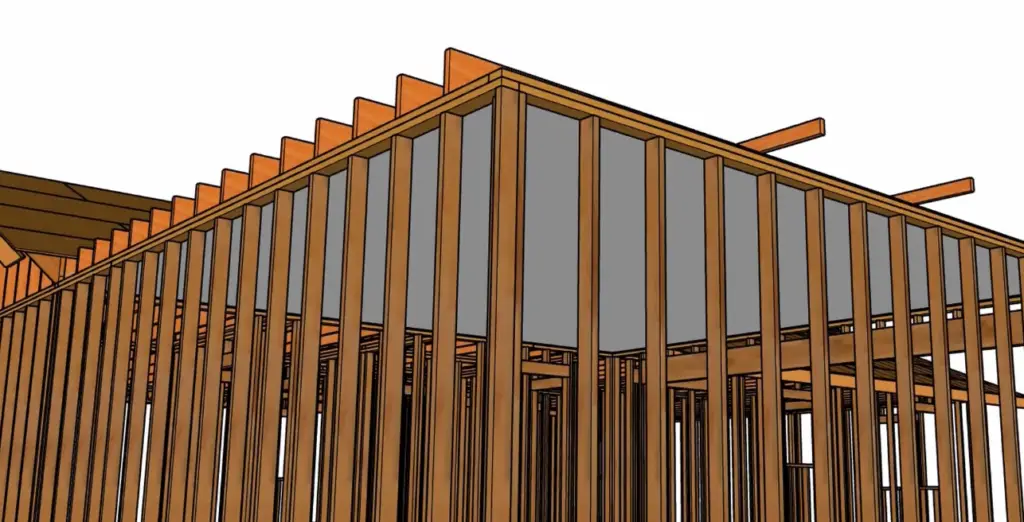
Can I Cut a Ceiling Joist?
Most of the time, it is not a good idea to cut a ceiling joist. This could make the ceiling weaker and less safe. But if you need to add another joist or adjust the size of an existing one, then you might have to cut it.
If so, ask a professional for help before trying to do it yourself. They can tell you how to cut the joist safely and correctly.
Whether you are installing new joists or making adjustments to existing ones, it is important to make sure that they are of the appropriate size and strength for the weight they need to support. Take time to do your research and consult a professional if needed.
How to Find a Ceiling Joist?
Finding a ceiling joist can be tricky, but there are a few signs that you can look for to help you find one. Look for cracks in the walls or ceilings, bulges in the floor, or beams running across the room—these could all indicate that there is a joist present.
You can also use a stud finder to detect the presence of metal or wood joists. Additionally, magnets can be used to detect steel and concrete joists.
How Does a Ceiling Joist Differ from a Beam?
Ceiling joists are thinner and lighter than beams. They are usually made of wood, which is stronger than steel or concrete.
Beams are larger and heavier. They are made of steel or concrete. Both support the weight of a ceiling, but they differ in size, shape, and material.
FAQ
What is the difference between ceiling joists and rafters?
Ceiling joists are horizontal boards that support the weight of a ceiling. They are usually made of wood and are lighter than beams. Rafters are sloped boards that create the shape of a roof or ceiling. They provide support for the roof, but they don’t hold up the weight of a ceiling like joists do.
How do I know where my ceiling joists are?
Look for cracks in the walls or ceilings, bulges in the floor, or beams running across the room—these could all indicate that there is a joist present. You can also use a stud finder to detect the presence of metal or wood joists. Additionally, magnets can be used to detect steel and concrete joists.
What are the 2 functions of ceiling joists?
Ceiling joists are used to support the weight of the ceiling and act as a sound barrier between floors. They also can be used to create an airtight seal around ducts and pipes that run through them.
Make sure that your ceiling joists are spaced correctly, that they are the right size for the weight they need to support, and that they are made of the right material.
Do you need ceiling joists?
Ceiling joists are important in any home or building. They help support the ceiling and keep it up. They also provide strength and stability. Make sure your ceiling joists are spaced apart correctly, that they are the right size to hold up the weight they need to, and that they are made of the right material.
Are ceiling joists load-bearing?
Yes, ceiling joists are load-bearing. They help to support the weight of the ceiling and they need to be installed correctly so that the ceiling is safe and strong.
What should I do if I need to cut my ceiling joist?
It is not usually a good idea to cut a ceiling joist. This could make the ceiling weaker and less safe. But if you need to add another joist or adjust the size of an existing one, then you might have to cut it.
If so, ask a professional to help you make sure that it is done safely and correctly. Take your time to do research and consult an expert if needed.
How often should ceiling joists be replaced?
Ceiling joists typically do not need to be replaced, but it is important to inspect them regularly for signs of wear and tear. If you notice any cracks, bulges in the floor, or weakening of the material, then it’s best to replace the joist as soon as possible. Make sure that all new joists are the correct size, materials, and spacing for the weight they need to support.
How can I make sure my ceiling joists are strong and secure?
You should check your ceiling joists often. Make sure they are the right size and spaced correctly. They also need to be made of the right material.
Additionally, all joist connections should be checked to make sure they are secure. If there is any sign of structural damage, you should have a professional inspect it before continuing with renovations or repairs.
Why should I install ceiling joists?
Ceiling joists are an important part of any building. They hold up the weight of a ceiling, help keep the structure of a building strong and secure, and act as a sound barrier between floors.
If you’re planning on doing any renovations or repairs to your home or building, it’s important to make sure that your ceiling joists are installed correctly. This will ensure that your ceilings and walls remain safe and secure.
Do ceiling joists need to be insulated?
It depends on the type of ceiling joists you have. Metal, concrete, and wood joists may not need insulation because they are already good insulators. However, if you have exposed or uninsulated joists, then it’s a good idea to add insulation. This will help keep the temperature in your home or building more consistent and comfortable.
Are ceiling joists hard to install?
No, you don’t need to be an expert to install ceiling joists. But you do need the right tools and materials. Make sure that you measure and cut the joists correctly, then use the right screws or nails to secure them into place. If you’re unsure of any steps in the process, it’s best to ask someone who knows for help.
Is there any maintenance I need to do for my ceiling joists?
Yes, it’s important to check your ceiling joists regularly for signs of wear and tear. Make sure they are still spaced correctly and that all connections are secure. If you notice any cracks or bulges in the floor, replace the joist as soon as possible.
Are ceiling joists expensive?
The price of ceiling joists varies depending on the material and size. Wood joists are usually cheaper than metal or concrete joists. Installation costs should also be considered when thinking about the total price of the project. It is a good idea to get quotes from different contractors or suppliers to get an idea of how much it will cost.
Does the size of the ceiling joist affect its strength?
Yes, the size and spacing of the joists determines how strong they are. The larger and closer together the joists are, the stronger they will be. Make sure that you measure your space correctly before ordering so that you get joists that are sized appropriately for your project. This will help ensure that your ceiling is strong and secure.
Do I need to use special tools or materials for installing ceiling joists?
Yes, you need to use the right type of screws or nails to attach the joists to the frame. If you’re planning a bigger project, you may want to get a power drill and other tools. If you don’t know what tools to get, ask a professional contractor or supplier.
Installing ceiling joists can be a difficult and time-consuming task. But if you take the time to do it properly, your ceilings will be strong and secure for years to come. Make sure that you measure your space correctly before buying materials, and use the right tools and materials for the job. Finally, be sure to inspect your joists regularly for signs of wear and tear. With a little bit of care and maintenance, you can ensure that your ceilings remain strong and secure for years to come.
Which type of ceiling joists should I use?
The type of joist you choose depends on your budget and the size and weight of the ceiling. Metal, concrete, and wood joists are all good options that can provide plenty of support for a ceiling. However, it’s always best to consult with an expert before making a decision so that you get the right type of joist for your project.
Can I use ceiling joists for other projects?
Ceiling joists can be used in lots of different kinds of home improvement projects. For example, you could use them to support a wall or build a deck or shed. But before you start, make sure that the joists are strong enough to hold up whatever you plan to build. If they’re not, you might need to buy stronger joists or add extra support beams.
How long do ceiling joists last?
The length of time your joists will last depends on the material and how well they are maintained. Usually, metal, concrete, and wood joists can all last for a long time if they are installed correctly and inspected regularly. But it is always best to ask an expert before beginning any project so that you get the right type of joist for your needs.
Ceiling joists are an important part of any home improvement project. They help hold up ceilings and other structures. If you do a good job installing them and taking care of them, they can last for many years. Before you start a project, make sure that you measure correctly, use the right materials and tools, and check your joists regularly to make sure they are still safe and secure.
When do I need to replace my ceiling joists?
You should check your ceiling joists every 2-3 years for damage. If you see any cracks or weak spots, you need to replace the joist right away.
With proper care and maintenance, your ceiling joists can last for many years, but you need to keep an eye on them to make sure they are still safe and secure.
Does the type of joist affect its strength?
Yes, the size and spacing of the joists determines how strong they are. The larger and closer together the joists are, the stronger they will be. Make sure that you measure your space correctly before ordering so that you get joists that are sized appropriately for your project. This will help ensure that your ceiling is strong and secure.
What do ceiling joists attach to?
Ceiling joists are usually attached to beams or a framework that supports the weight of the ceiling. The type of framework will depend on the type and size of your project, but it should be able to support the weight of the ceiling joists and any materials they are holding up.
Can I install ceiling joists myself?
You can install ceiling joists yourself if you have the right tools and materials. But it is important to do it safely. Follow all safety guidelines and use the correct tools for the job. If you’re not sure how to install the joists, ask an expert for help. This will make sure that your ceiling is strong and secure.
Useful Video: Rafter Ties Versus Ceiling Joists – Which One Do I Need?
Conclusion
Ceiling joists are an important but often overlooked part of your home’s structure. By understanding what they are and how they work, you can make sure that your ceiling is strong and stable for years to come.
Thanks for reading, and we hope this article has given you a better idea of what goes into keeping your ceilings in good shape.
If you have any questions or would like more information, please feel free to contact us. We’re always happy to help!
References
- https://cbsmn.com/ceiling-joist/
- https://weekendbuilds.com/what-are-ceiling-joists/














Leave a Reply